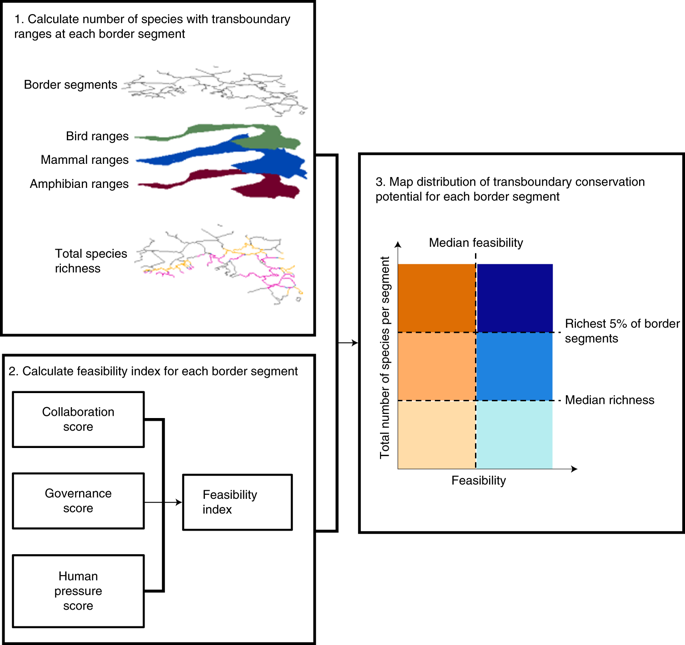当前位置:
X-MOL 学术
›
Nat. Ecol. Evol.
›
论文详情
Our official English website, www.x-mol.net, welcomes your
feedback! (Note: you will need to create a separate account there.)
Global opportunities and challenges for transboundary conservation.
Nature Ecology & Evolution ( IF 13.9 ) Pub Date : 2020-03-23 , DOI: 10.1038/s41559-020-1160-3 Natalie Mason 1 , Michelle Ward 1, 2 , James E M Watson 1, 2, 3 , Oscar Venter 4 , Rebecca K Runting 5
Nature Ecology & Evolution ( IF 13.9 ) Pub Date : 2020-03-23 , DOI: 10.1038/s41559-020-1160-3 Natalie Mason 1 , Michelle Ward 1, 2 , James E M Watson 1, 2, 3 , Oscar Venter 4 , Rebecca K Runting 5
Affiliation

|
Rapid biodiversity loss has prompted global action to prevent further declines, yet coordinated conservation action among nations remains elusive. As a result, species with ranges that span international borders-which include 53.8% of terrestrial birds, mammals and amphibians-are in increasing peril through uncoordinated management and artificial barriers to human movement, such as border fences. Transboundary conservation initiatives represent a unique opportunity to better protect species through coordinated management across national borders. Using metrics of governance, collaboration and human pressure, we provide an index of transboundary conservation feasibility to assess global opportunities and challenges for different nations. While the transboundary conservation potential of securing multinational threatened species varied substantially, there are distinct opportunities in South-East Asia, Northern Europe, North America and South America. But to successfully avert the loss of transboundary species, the global community must be prepared to invest in some regions facing greater implementation challenges, including the nations of Central Africa, where efforts may necessitate establishing rapid conservation interventions postconflict that align with local socio-cultural opportunities and constraints. Sanctioned and coordinated approaches towards managing transboundary species are now essential to prevent further declines of many endangered species, and global policy efforts must do more to produce and enact legitimate mechanisms for collaborative action in conservation.
中文翻译:

跨界保护的全球机遇和挑战。
生物多样性的迅速丧失促使采取全球行动防止进一步下降,但各国之间协调的保护行动仍然遥遥无期。结果,跨越国际边界的物种(包括53.8%的陆生鸟类,哺乳动物和两栖动物)由于不协调的管理和人为移动的人为屏障(如边界围栏)而处于危险之中。跨界保护举措是通过跨国界协调管理更好地保护物种的独特机会。利用治理,协作和人员压力的指标,我们提供了跨界保护可行性的指数,以评估不同国家的全球机遇和挑战。确保多国濒危物种的越境保护潜力差异很大,在东南亚,北欧,北美和南美有不同的机会。但是,为了成功避免跨界物种的流失,国际社会必须准备在一些面临更大实施挑战的地区进行投资,包括中非国家,在这些地区,可能需要努力在冲突后建立与当地社会文化机遇相适应的快速保护措施和约束。现在,为防止许多濒危物种的进一步减少,必须采取经制裁和协调一致的方法来管理跨界物种,全球政策努力必须做出更多努力,以产生并制定合法的保护合作行动机制。但是,为了成功避免跨界物种的流失,国际社会必须准备在一些面临更大实施挑战的地区进行投资,包括中非国家,在这些地区,可能需要努力在冲突后建立与当地社会文化机遇相适应的快速保护措施和约束。现在,为防止许多濒危物种的进一步减少,必须采取经制裁和协调一致的方法来管理跨界物种,全球政策努力必须做出更多努力,以产生并制定合法的保护合作行动机制。但是,为了成功避免跨界物种的流失,国际社会必须准备在一些面临更大实施挑战的地区进行投资,包括中非国家,在这些地区,可能需要努力在冲突后建立与当地社会文化机遇相适应的快速保护措施和约束。现在,为防止许多濒危物种的进一步减少,必须采取经制裁和协调一致的方法来管理跨界物种,全球政策努力必须做出更多努力,以产生并制定合法的保护合作行动机制。在这些地方可能需要做出努力,以便在冲突后建立与当地社会文化机会和限制相一致的快速保护措施。现在,为防止许多濒危物种的进一步减少,必须采取经制裁和协调一致的方法来管理跨界物种,全球政策努力必须做出更多努力,以产生并制定合法的保护合作行动机制。在这些地方可能需要做出努力,以便在冲突后建立与当地社会文化机会和限制相一致的快速保护措施。现在,为防止许多濒危物种的进一步减少,必须采取经制裁和协调一致的方法来管理跨界物种,全球政策努力必须做出更多努力,以产生并制定合法的保护合作行动机制。
更新日期:2020-04-24
中文翻译:

跨界保护的全球机遇和挑战。
生物多样性的迅速丧失促使采取全球行动防止进一步下降,但各国之间协调的保护行动仍然遥遥无期。结果,跨越国际边界的物种(包括53.8%的陆生鸟类,哺乳动物和两栖动物)由于不协调的管理和人为移动的人为屏障(如边界围栏)而处于危险之中。跨界保护举措是通过跨国界协调管理更好地保护物种的独特机会。利用治理,协作和人员压力的指标,我们提供了跨界保护可行性的指数,以评估不同国家的全球机遇和挑战。确保多国濒危物种的越境保护潜力差异很大,在东南亚,北欧,北美和南美有不同的机会。但是,为了成功避免跨界物种的流失,国际社会必须准备在一些面临更大实施挑战的地区进行投资,包括中非国家,在这些地区,可能需要努力在冲突后建立与当地社会文化机遇相适应的快速保护措施和约束。现在,为防止许多濒危物种的进一步减少,必须采取经制裁和协调一致的方法来管理跨界物种,全球政策努力必须做出更多努力,以产生并制定合法的保护合作行动机制。但是,为了成功避免跨界物种的流失,国际社会必须准备在一些面临更大实施挑战的地区进行投资,包括中非国家,在这些地区,可能需要努力在冲突后建立与当地社会文化机遇相适应的快速保护措施和约束。现在,为防止许多濒危物种的进一步减少,必须采取经制裁和协调一致的方法来管理跨界物种,全球政策努力必须做出更多努力,以产生并制定合法的保护合作行动机制。但是,为了成功避免跨界物种的流失,国际社会必须准备在一些面临更大实施挑战的地区进行投资,包括中非国家,在这些地区,可能需要努力在冲突后建立与当地社会文化机遇相适应的快速保护措施和约束。现在,为防止许多濒危物种的进一步减少,必须采取经制裁和协调一致的方法来管理跨界物种,全球政策努力必须做出更多努力,以产生并制定合法的保护合作行动机制。在这些地方可能需要做出努力,以便在冲突后建立与当地社会文化机会和限制相一致的快速保护措施。现在,为防止许多濒危物种的进一步减少,必须采取经制裁和协调一致的方法来管理跨界物种,全球政策努力必须做出更多努力,以产生并制定合法的保护合作行动机制。在这些地方可能需要做出努力,以便在冲突后建立与当地社会文化机会和限制相一致的快速保护措施。现在,为防止许多濒危物种的进一步减少,必须采取经制裁和协调一致的方法来管理跨界物种,全球政策努力必须做出更多努力,以产生并制定合法的保护合作行动机制。











































 京公网安备 11010802027423号
京公网安备 11010802027423号